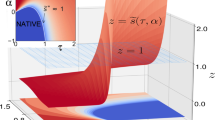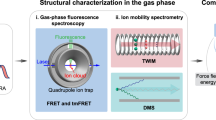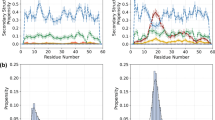Abstract
Using an empirical analysis of experimental data we have estimated a set of energy contributions which accounts for the stability of isolated α-helices. With this database and an algorithm based on statistical mechanics, we describe the average helical behaviour in solution of 323 peptides and the helicity per residue of those peptides analyzed by nuclear magnetic resonance. Moreover the algorithm successfully detects the α-helical tendency, in solution, of a peptide corresponding to a β-strand of ubiquitin.
This is a preview of subscription content, access via your institution
Access options
Subscribe to this journal
Receive 12 print issues and online access
$189.00 per year
only $15.75 per issue
Buy this article
- Purchase on Springer Link
- Instant access to full article PDF
Prices may be subject to local taxes which are calculated during checkout
Similar content being viewed by others
References
Serrano, L., Matouschek, A.R. & Fersht, A.R. The folding of an enzyme VI: the folding pathway of Barnase. Comparison with theoretical models. J. molec. Biol. 224, 847–859 (1992).
Matthews, C.R. Pathways of protein folding. A. Rev. Biochem. 62, 653–683 (1993).
Zimm, B.H. & Brag, J.K. Theory of the phase transition between helix and random coil in polypeptide chains. J. chem. phys. 31, 526 (1959).
von Dreele, P.H., Lotan, N., Ananthanarayan, V.S., Andreatta, R.H., Poland, D. & Scheraga, H.A. Helix-coil stability parameters for the naturally occurring amino acids in water. II. Characterization of host polymers and application of host-guest technique to random poly[(hydroxypropyl)glutamine-co-(hydroxybuthyl)glutamine]. Macromolecules 4, 408–417 (1971).
Finkelstein, A.V., Badretinov, A.Y. & Ptitsyn, O.B. Physical reasons for secondary structure stability: α-helices in short peptides. Proteins Struc. Func. Genet. 10, 287 (1991)
Ptitsyn, O.B. Secondary structure formation and stability. Curr. Opin. struct. Biol. 2, 13–20 (992).
Finkelstein, A.V. & Ptitsyn, O.B. A theory of protein molecule self organization. IV. Helical and irregular local structures of unfolded protein chains. J. molec. Biol. 103, 15 (1976).
Gans, P.J., Lyu, P.C., Manning, M.C., Woody, R.W. & Kallenbach, N.R. . The helix-coil transition in heterogeneous peptides with specific side-chain interactions: theory and comparison with CD spectral data. Biopolymers 31, 1605–1614 (1991).
Chen, C.C., Zhu, Y., King, J.A. & Evans, L. A molecular thermodynamic approach to predict the secondary structure of homopolypeptides in aqueous systems. Biopolymers 32, 1375–1392 (1992).
Qian, H. Single-residue substitution in homopolypeptides: perturbative helix-coil theory at a single site. Biopolymers 33, 1605–1616 (1993).
Dyson, H.J. & Wright, P. Peptide conformation and protein folding. Curr. Opin. struct. Biol. 3, 60–65 (1993).
Fukugita, M., Lancaster, D. & Mitchard, M.G. Kinematics and thermodynamics of a folding heteropolymer. Proc. natn. Acad. Sci. U.S.A. 90, 6365–6368 (1993).
Park, S.H., Shalongo, W. & Stellwagen, E. Residue helix parameters obtained from dichroic analysis of peptides of defined sequence. Biochemistry 32, 7048–7053 (1993).
Serrano, L., Sancho, J., Hirshberg, J.M. & Fersht, A.R. α-Helix stability in proteins. I. Empirical correlations concerning substitution of side chains at the N- and C-caps and the replacement of alanine by glicine or serine at solvent -exposed surfaces. J. molec. Biol. 227, 544–549 (1992).
Serrano, L. & Fersht, A.R. Capping and alpha-helix stability. Nature 342, 296–299 (1989).
Nicholson, H., Anderson, D.E., Dao-Pin, S. & Matthews, B.W. Analysis of the interaction between charged side chains and the α-helix dipole using designed thermostable mutants of phage T4 lysozyme. Biochemistry 30, 981–9828 (1991).
Bell, J.A., Becktel, W.J., Sauer, U., Baase, W.A. & Matthews, B.W. Dissection of helix capping in T4 Lysozyme by structural and thermodynamical analysis of six aminoacid substitutions at Thr59. Biochemistry 31, 3590–3596 (1992).
Sancho, S., Serrano, L. & Fersht, A.R., Histidine Residues at the N- and C-termini of α-Helices: Perturbed pKas and Protein Stability. Biochemistry 31, 2253–2258 (1992).
Horovitz, A., Matthews, J. & Fersht, A.R. Alpha-helix stability in proteins. II. Factors that influence stability at an internal position. J. molec. Biol. 227, 560–568 (1992).
Blaber, M., Zang, X. & Matthews, B. Structural basis of amino acid α helix propensity. Science 260, 1637–1640 (1993).
Jimenez, M.A., Nieto, J.L., Herranz, J., Rico, M. & Santoro, J. 1H NMR and CD evidence of the folding of the isolated ribonuclease 50-61 fragment. FEBS Lett. 221, 320 (1987).
Jimenez, M.A., Rico, M., Herranz, J., Santoro, J. & Nieto, J.L. 1H-NMR assignment and folding of the isolated ribonuclease 21-42 fragment. Eur. J. Biochem. 175, 101–109 (1988).
Goodman, E.M. & Kim, P.S. Folding of a peptide corresponding to α-helix in bovine pancreatic typsin inhibitor. Biochemistry 28, 4333–4337 (1989).
Peña, M.C., Rico, M., Jimenez, M.A., Herranz, J., Santoro, J. & Nieto, J.L. Conformational properties of the isolated 1-23 fragment of human hemoglobin α-chain. Biochem. biophys. Acta. 957, 380–389 (1989).
Dyson, H.J., Merutka, G., Waltho, J.P., Lerner, R.A. & Wright, P.E. Folding of peptide fragments comprising the complete sequence of proteins. Models for initiation of protein folding. I Myohemerythrin. J. molec. Biol. 226, 795–817 (1992).
Dyson, H.J., Merutka, G., Waltho, J.P., Lerner, R.A. & Wright, P.E. Folding of peptide fragments comprising the complete sequence of proteins. Models for initiation of protein folding. II Plastocyanin. J. molec. Biol. 226, 817–835 (1992).
Blanco, F.J., Jimenez, M.A., Rico, M., Santoro, J., Herranz, J. & Nieto, J.L. The homologous angiogenin and ribonuclease N-terminal fragments fold into very similar helices when isolated. Biochem. biophys. res. Commun. 182, 1491–1498 (1992).
Brown, J.E. & Klee, W.A. Helix-coil transition of the isolated amino terminus of ribonuclease. Biochemistry 10, 470–476 (1971).
Jimenez, M.A. et al. CD and 1H-NMR studies on the conformational properties of peptide fragments from the C-terminal domain of thermolysin. Euro. J. Biochem. 211, 569–581 (1993).
Shin, H.C., Merutka, G., Waltho, J.P., Wright, P.E. & Dyson, H.J. Peptide models of protein folding initiation sites. 2. The G-H turn region of myoglobin act as a helix stop signal. Biochemistry 32, 6348–6355 (1993).
Shin, H.C., Merutka, G., Waltho, J.P., Tennant, L.L., Dyson, H.J. & Wright, P.E. Peptide models of protein folding initiation sites. 3. The G-H helical hairpin of myoglobin. Biochemistry 32, 6356–6364 (1993).
Precheur, B., Siffert, O., Barzu, O. & Craescu, C.T. NMR and circular dichroic studies on the solution conformation of a synthetic peptide derived from the calmodulin-binding domain of Bordetella pertussis adenylate cyclase. Euro. J. Biochem. 196, 67–72 (1991).
Mammi, S., Foffani, M.T., Improta, S., Tessari, M., Schierano, E. & Peggion, E. Conformation of uteroglobin fragments. Biopolymers 32, 341 (1992).
Sancho, J., Neira, J.L. & Ferhst, A.R., An N-terminal fragment of Barnase has residual structure similar to that in a refolding intermediate. J. molec. Biol. 224, 749–758. (1992).
Cushman, J.A., Mishra, P.K., Bothner, A.A. & Khosla, M.S. Conformations in solution of angiotensin II, and its 1-7 and 1-6 fragments. Biopolymers 32, 1163–1171 (1992).
Kuroda, Y. Residual helical structure in the C-terminal fragment of cytochrome C. Biochemistry 32, 1219–1224 (1993).
Yumoto, N., Murase, S., Hattori, T., Yamamoto, H., Tatsu, Y. & Yoshikawa, S. Stabilization of α-helix in C-terminal fragments of neuropeptide Y. Biochem. biophys. res. Comm. 196, 1490–1495 (1993).
Doughty, M.B. & Hu, L. The contribution of helical potential to the in vitro receptor binding activity of a neuropeptide Y N-terminal deletion fragment. Biopolymers 33, 1201–1206 (1993).
Kemmink, J. & Creighton, T.E. Conformations of peptides representing the entire sequence of bovine pancreatic trypsin inhibitor (BPTI) and their roles in folding. J. molec. Biol. (in the press).
Waltho, J.P., Feher, V.A., Merutka, G., Dyson, H.J. & Wright, P.E. Peptide models of protein folding initiation sites. 1. Secondary structure formation by peptides corresponding to the G- and H-helices of myoglobin. Biochemistry 32, 6337–6347 (1993).
Munier, H. et al. Characterisation of a Synthetic Calmodulin-binding Peptide derived J. biol. Chem.. 268, 1695 (1993).
Sonnichsen, F.D., Van Eyk, J.E., Hodges, R.S. & Sykes, B.D. Effect of trifluoroethanol on protein secondary structure: an NMR and CD study using a synthetic actin peptide. Biochemistry 31, 8790–8798 (1992).
Chakrabarty, B.D., Doig, A.J. & Baldwin, R.L., Helix N-cap propensities in peptides parallel those found in proteins. Proc. natn. Acad. Sci. U.S.A. (in the press).
Mitchinson, C. & Baldwin, R.L. The design and production of semisynthetic ribonucleases with increased thermostability by incorporation of S-peptide analogs with enhanced helical stability. Proteins Struct. Func. Genet. 1, 23–33 (1986).
Schoemaker, K.R., Kim, P.S., York, E.J., Stewart, J.M. & Baldwin, R.L. Tests of the helix dipole model for stabilisation of α-helices Nature 326, 563–567 (1987).
Strehlow, K.G. & Baldwin, R.L. Effect of the substitution Ala-Gly at each of five residue positions in the C-peptide helix. Biochemistry 28, 2130–2133 (1989).
Lyu, P.C., Marky, L.A. & Kallenbach, N.R. The role of ion pairs in α-helix stability: two new designed helical peptides. J. Am. chem. Soc. 111, 2733–2734. (1989).
Marqusee, S., Robbins, V.H. & Baldwin, R.L. Unusually stable helix formation in short alanine-based peptides. Proc. natn. Acad. Sci. U.S.A. 86, 5286–5290 (1989).
Fairman, R., Shoemaker, K.R., York, E.J., Stewart, J.M. & Baldwin, R.L. Further studies of the helix dipole model: Effects of a free α-NH3 + or α-COO− group on helix stability. Proteins Struc. Func. Genet. 5, 1–7 (1989).
Merutka, G. & Stellwagen, E. Positional independence and additivity of amino acid replacements on helix stability in monomeric peptides. Biochemistry 29, 894–898 (1990).
Merutka, G., Lipton, W., Shalongo, W., Park, S.H. & Stellwagen, E. Effect of central-residue replacements on the helical stability of a monomeric peptide. Biochemistry 29, 7511–7515 (1990).
Lyu, P.C., Liff, M.I., Marky, L.A. & Kallenbach, N.R. Side chain contributions to the stability of alpha-helical structures in peptides. Science 250, 669–673 (1990).
Padmanabhan, S., Marqusee, S., Ridgeway, T., Laue, T.M., Baldwin, R.L. Relative helix-forming tendencies of nonpolar amino acids. Nature 344, 268–270 (1990).
Shoemaker, R.K. et al. Side Chain interactions in the C-peptide Helix Phe8…His12. Biopolymers 29, 1 (1990).
Merutka, G. & Stellwagen, E. Effect of amino acid ion pairs on peptide helicity. Biochemistry 30, 1591–1594 (1991).
Lyu, P.C., Wang, P.C., Liff, M.I. & Kallenbach, N.R. Local effect of glycine substitution in a model helical peptide. J Am. chem. Soc. 113, 3568–3572 (1991).
Padmanabhan, S. & Baldwin, R.L. Straight-chain non-polar amino acids are good helix-formers in water. J. molec. Biol. 219, 135–137 (1991).
Strehlow, K.G., Robertson, A.D. & Baldwin, R.L. Proline for alanine substitutions in the C-peptide helix of ribonuclease A. Biochemistry 30, 5810–5814 (1991).
Scholtz, M., Qian, H., York, E.J., Stewart, J.M. & Baldwin, R.L. Parameters of helix-coil transition theory for alanine-based peptides of varying chain lengths in water. Biopolymers 31, 1463–1470 (1991).
Chakrabartty, A., Schellman, J.A. & Baldwin, R.L. Large differences in the helix propensities of alanine and glycine. Nature 351, 586–588 (1991).
Lyu, P.C., Zhou, H.X., Jelveh, N., Wemmer, D.E. & Kallenbach, N.R. Position-dependent stabilizing effects in α-helices: N-terminal capping in synthetic model peptides. J. Am. chem. Soc. 114, 6560–6562 (1992).
Stellwagen, E., Park, S., Shalongo, W. & Jain, A. The contribution of residue ion pairs to the helical stability of a model peptide. Biopolymers 32, 1193–1200 (1992).
Lyu, P.C., Wemmer, D.E., Hongxing, X.Z., Pinker, R.J. & Kallenbach, N.R. Capping interactions in isolated α helices: Position-dependent substitution effects and structure of a Serine-capped peptide helix. Biochemistry 32, 421–425. (1993).
Huygues-Despointes, B.M.P., Scholtz, J.M. & Baldwin, R.L. Effect of a single aspartate on helix stability at different positions in a neutral alanine-based peptide. Prot. Sci. 2, 1604–1611 (1993).
Huyghues-Despointes, B.M.P., Scholtz, J.M. & Baldwin, R.L. Helical peptides with three pairs of Asp-Arg and Glu-Arg residues in different orientations and spacings. Prot. Sci. 2, 80–85 (1993).
Venkatachallapathi, Y.V. et al. Effect of end group blockage on the properties of a class A amphipathic helical peptide. Proteins Struct. Func. Genet. 15, 349–359 (1993).
Forood, B., Feliciano, E.J. & Nambiar, K.P. Stabilization of α-helical structures in short peptides via end capping. Proc. natn. Acad. Sci. U.S.A. 90, 838–842 (1993).
Chakrabartty, A., Kortemme, T., Padmanabhan, S. & Baldwin, R.L. Aromatic side-chain contribution to far-ultraviolet circular dichroism of helical peptides and its effect on measurement of helix propensities. Biochemistry 32, 5560–5565. (1993).
Zhou, N.E., Kay, C.M., Sykes, B.D., Hodges, R.S. A single-stranded amphipatic α-helix in aqueous solution: design, structural characterisation, and its application for determining α-helical propensities of amino acids. Biochemistry 32, 6190–6197 (1993).
Fairman, R., Armstrong, K.M., Shoemaker, K.R., York, E.J., Stewart, J.M. & Baldwin, R.L. Position effect on apparent helical propensities in the C-peptide helix. J. molec. Biol. 221, 1395–1401 (1991).
Scholtz, J.M., York, E.J., Stewart, J.M. & Baldwin, R.L. A Neutral water-soluble, α-helical peptide: The effect of ionic strength on the helix-coil equilibrium. J. Am. chem. Soc. 113, 5102 (1991).
Flory, P.J. Statistical mechanics of chain molecules (Hansen Publishers, 1989).
O'Neil, K.T. & DeGrado, W.F. A thermodynamic scale for the helix-forming tendencies of the commonly occurring amino acids. Science 250, 646–650 (1990).
Scholtz, J.M., Marqusee, S., Baldwin, R.L., York, E.J., Stewart, J.M., Santoro, M., Bolen, D.W. Calorimetric determination of the enthalpy change for the α-helix to coil transition of an alanine peptide in water. Proc. natn. Acad. Sci. U.S.A. 88, 2854–2858 (1991).
Ooi, T. & Obatake, M. Prediction of the thermodynamics of protein unfolding: the helix-coil transition of poly(L-alanine). Proc. natn. Acad. Sci. U.S.A. 88, 2859–2863 (1991).
Sippl, M. Calculation of conformation ensembles from potentials of mean force. An approach to the knowledge-based prediction of local structures in globular proteins. J. molec. Biol. 213, 859–883. (1990).
Rooman, M.J., Koger, J.P.A. & Wodak, S.J. Extracting information on folding from the aminoacid sequence: accurate predictions for protein regions with preferred conformations in the absence of tertiary interactions. Biochemistry 31, 10226–10238 (1992).
Richardson, J.S. & Richardson, D.C. Amino acid preferences for specific locations at the ends of α helices. Science 240, 1648–1652 (1988).
Dasgupta, S. & Bell, J.A. Design of helix ends. Int. J. peptide protein Res. 41, 499–511 (1993).
Harper, E.T. & Rose, G.D. Helix stop signals in proteins and peptides: the capping box. Biochemistry 32, 7605–7609 (1993).
Chen, Y.H., Yang, J.T. & Chau, K.H. Determination of the helix and β-form of proteins in aqueous solution by circular dichroism. Biochemistry 13, 3350–3359 (1974).
Storrs, R.W., Truckses, D. & Wemmer, D.E. Helix propagation in trifluoroethanol solutions. Biopolymers 32, 1695–1702 (1992).
Jimenez, M.A., Blanco, F.J., Rico, M., Santoro, J., Herranz, J. & Nieto, J.L. Periodic properties of proton conformational shifts in isolated protein helices. Eur. J. Biochem. 207, 39–71 (1992).
Vijay-Kumar, S., Bugg, C.E. & Cook, W.J. Structure of Ubiquitin refined at 1.8 Å resolution. J. molec. Biol. 194, 531–544 (1987).
Stock, J.B., Stock, A.M. & Mottonen, J.M. Signal transduction in bacteria. Nature 344, 395–400 (1990).
Blanco, F.J. “Papel de los giros β en el plegamiento de proteinas: estudio por resonancia magnetica nuclear”. Universidad Complutense de Madrid. PhD dissertation. (1992).
Ogawa, K. et al. X-ray analysis of fereedoxin from S. platensis . 84, 1645–1652 (1978).
Weaber, L.H. & Matthews, B.W. Structure of bacteriophage T4 lysozyme refined at 1.7 Å resolution. J. molec. Biol. 193, 189 (1987).
Valencia, A., Chardin, P., Wittinghofer, A. & Sander, C. The ras protein family: evoultionary tree and role of conserved amino acids. Biochemistry 30, 4637–4648 (1991).
Gronenborg et al. A novel, highly stable fold of the Immunoglobulin binding domain of Streptococcal protein G. Science 253, 657–661 (1991).
Wutrich, K. NMR of proteins and nucleic acids (Wiley-lnterscience, 1986).
Rohl, C.A., Scholtz, J.M., York, E.J., Stewart, J.M. & Baldwin, R.L. Kinetics of proton exchange in helical peptides of varying chain lengths: interpretation by the Lifson-Roig equation. Biochemistry 31, 1263–1269 (1992).
Author information
Authors and Affiliations
Rights and permissions
About this article
Cite this article
Muñoz, V., Serrano, L. Elucidating the folding problem of helical peptides using empirical parameters. Nat Struct Mol Biol 1, 399–409 (1994). https://doi.org/10.1038/nsb0694-399
Received:
Accepted:
Issue Date:
DOI: https://doi.org/10.1038/nsb0694-399
This article is cited by
-
Rational peptide design for inhibition of the KIX–MLL interaction
Scientific Reports (2023)
-
Purification, conformational analysis and cytotoxic activities of host-defense peptides from the Tungara frog Engystomops pustulosus (Leptodactylidae; Leiuperinae)
Amino Acids (2023)
-
Rational design of a helical peptide inhibitor targeting c-Myb–KIX interaction
Scientific Reports (2022)
-
Controlling oncogenic KRAS signaling pathways with a Palladium-responsive peptide
Communications Chemistry (2022)
-
α-Helical peptidic scaffolds to target α-synuclein toxic species with nanomolar affinity
Nature Communications (2021)



